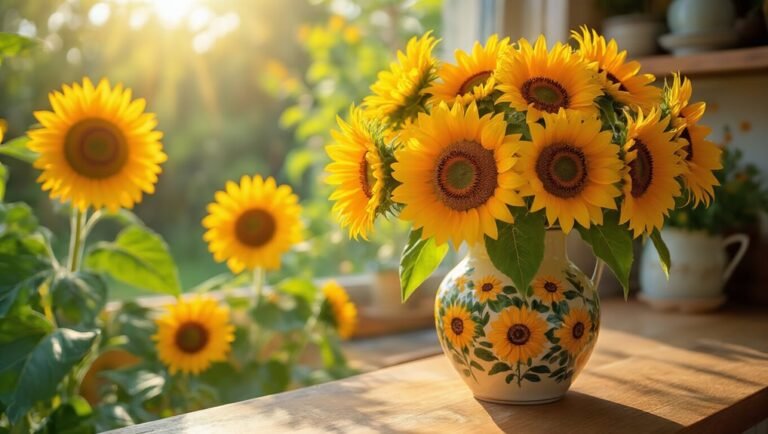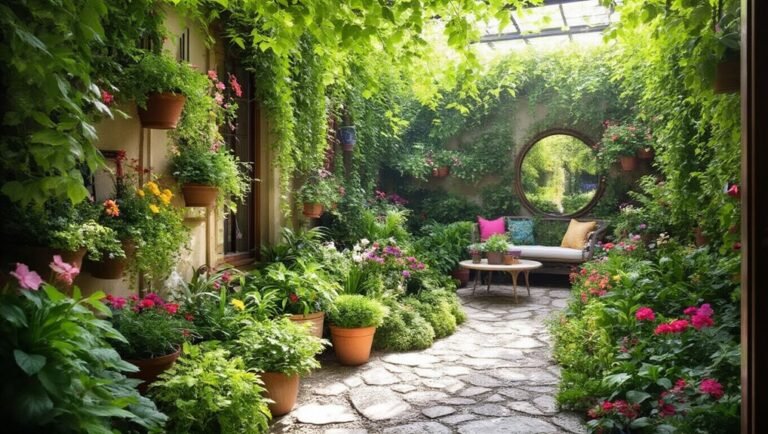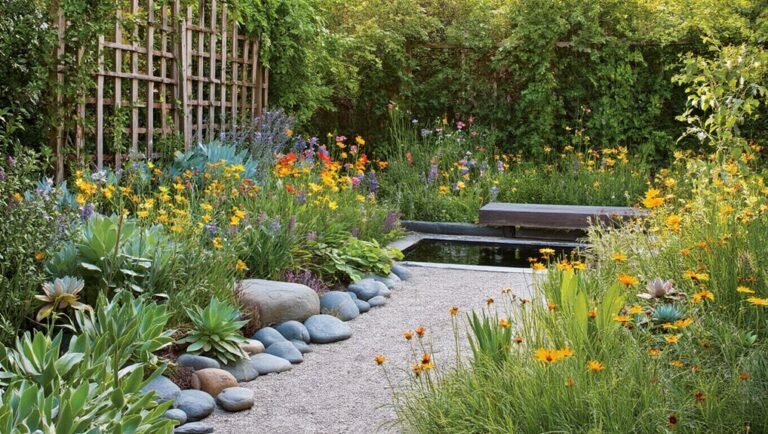If you’re looking to add stunning blue flowers to your garden, consider the Delphinium with its tall, vibrant spikes. The enchanting Bluebell creates a magical spring carpet, while Hydrangeas offer lush blooms in various shades. Lobelia adds delicate flowers in containers, and Forget-Me-Nots thrive in partial shade with their tiny blooms. Each of these choices brings unique beauty to your space. Keep exploring to discover even more beautiful blue options for your garden!
Key Takeaways
- Delphinium adds striking tall blue spikes to your garden, thriving in full sun and well-drained soil.
- Bluebell creates a magical spring carpet of blooms, flourishing in shaded woodland areas.
- Hydrangea offers large, vibrant blue flowers, with color influenced by soil pH and moisture levels.
- Lobelia provides delicate blue flowers in various shades, perfect for containers and attracting pollinators.
- Forget-Me-Not features tiny blue blooms, ideal for partial shade and naturalizing in wildflower gardens.
Delphinium
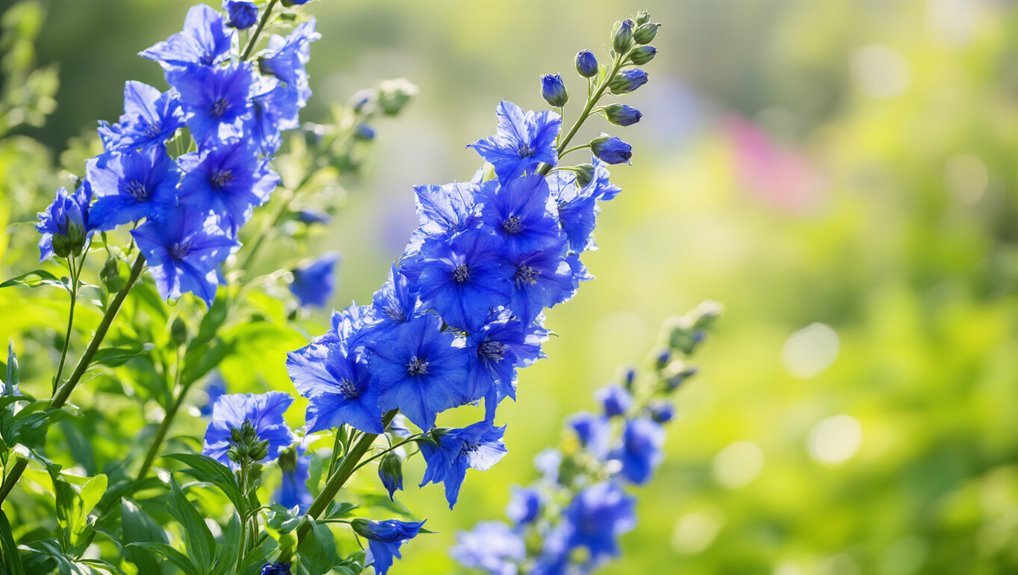
Delphinium, with its strikingly tall spikes of vibrant blue blooms, can transform any garden into a stunning visual feast. You’ll appreciate how these flowers add height and drama, creating a captivating focal point.
They thrive in well-drained soil and prefer full sun, so place them where they can soak up the sunlight. Regular watering will keep them looking their best, especially during dry spells. Don’t forget to stake taller varieties to prevent them from toppling over. For the best results, consider planting delphiniums in raised garden beds to elevate your gardening experience and improve drainage.
You can enjoy a longer blooming period by deadheading spent flowers. Plus, their attractive foliage complements other plants beautifully.
With a little care, delphiniums can flourish in your garden, inviting admiration from all who pass by. Embrace their beauty and enhance your landscape! For the healthiest growth, plant delphiniums in quality garden soil to ensure they receive the nutrients they need.
Bluebell
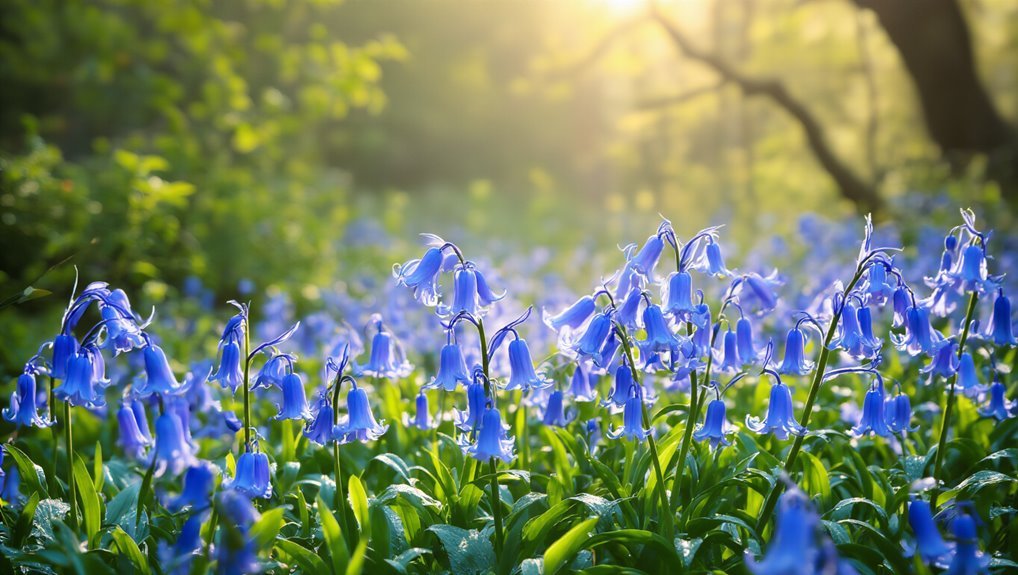
Bluebells create a magical carpet of blue in springtime gardens, captivating anyone who strolls by.
These charming flowers thrive in shaded areas, making them perfect for woodland gardens or the edges of your yard. Their delicate, drooping buds form clusters that sway gently in the breeze, adding a touch of elegance to your landscape. For gardeners interested in supporting their flowers, plant support clips can help keep bluebell stems upright and protected.
To grow bluebells, plant the bulbs in fall, ensuring they’re nestled in well-drained soil. They’ll reward you with beautiful blooms that last several weeks.
After flowering, let the foliage die back naturally to nourish the bulbs for next year. Keep an eye out for their enchanting fragrance, which can draw pollinators like bees.
If you want to protect bluebells from birds or other garden pests, consider using garden netting to safeguard their delicate blooms.
With bluebells, you’ll create a serene, picturesque spot in your garden.
Hydrangea
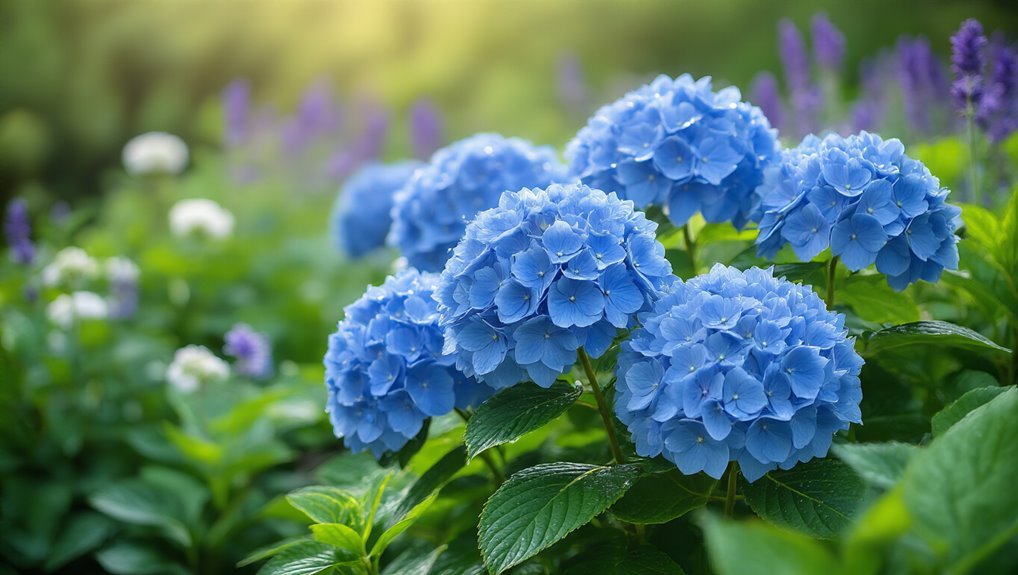
Hydrangeas are a stunning addition to any garden, known for their large, vibrant blooms that can range from deep blue to soft lavender.
These beautiful flowers can brighten up your outdoor space and create a serene atmosphere. To ensure your hydrangeas thrive, consider the following tips: For gardeners interested in sustainable practices, incorporating compost bins into your garden can enrich the soil and support healthier hydrangea growth.
- Choose the right variety: Some hydrangeas bloom on old wood, while others bloom on new wood; pick accordingly for your climate.
- Monitor soil pH: The color of your blooms can change based on soil acidity, so test and adjust it to achieve that perfect blue hue.
- Provide adequate moisture: These plants love water, so make sure to keep the soil consistently moist, especially during dry spells.
For the healthiest plants, you might consider starting your hydrangeas from seeds using essential seed starting kits to give them the best possible beginning. With the right care, your hydrangeas will flourish and steal the show!
Lobelia
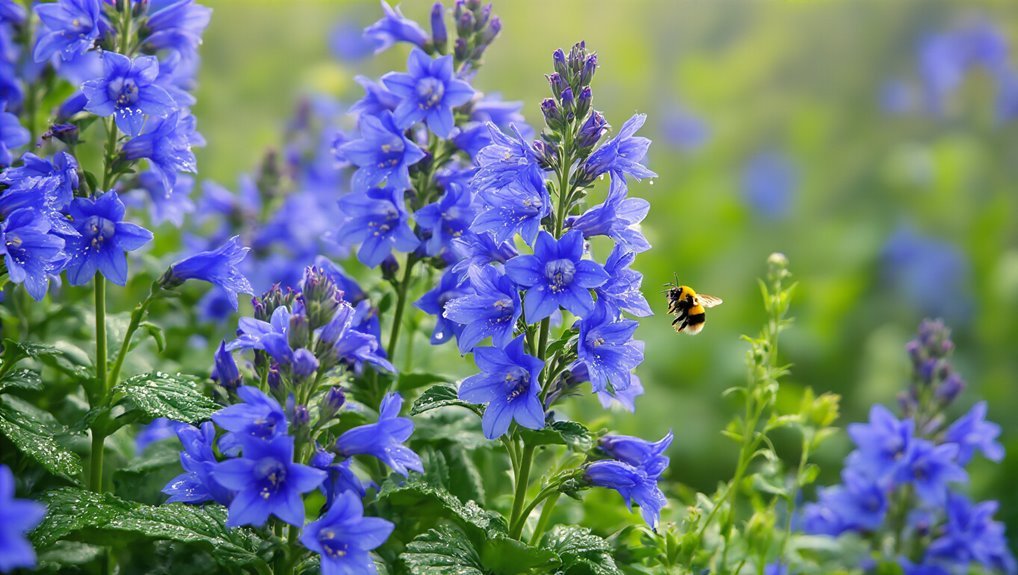
Lobelia adds a splash of vibrant blue to your garden, making it a favorite among gardeners. Its delicate flowers bloom in various shades of blue, creating a stunning contrast against lush greenery. You’ll find lobelia thrives in both containers and garden beds, bringing versatility to your landscape. Plus, it attracts pollinators, enhancing your garden’s ecosystem. For the healthiest and most vibrant blooms, consider nourishing your lobelia with the best plant food options to support strong growth. Using plant fertilizer tablets can further boost your garden’s overall plant health and vigor.
Here’s a quick comparison of lobelia varieties:
| Variety | Height | Bloom Time |
|---|---|---|
| Lobelia erinus | 6-12 inches | Summer to Fall |
| Lobelia siphilitica | 12-24 inches | Summer |
| Lobelia cardinalis | 24-36 inches | Mid-Summer |
| Lobelia x speciosa | 12-18 inches | Late Spring |
| Lobelia ‘Blue Moon’ | 10-12 inches | Summer |
Consider adding lobelia to your garden for a captivating blue display!
Forget-Me-Not
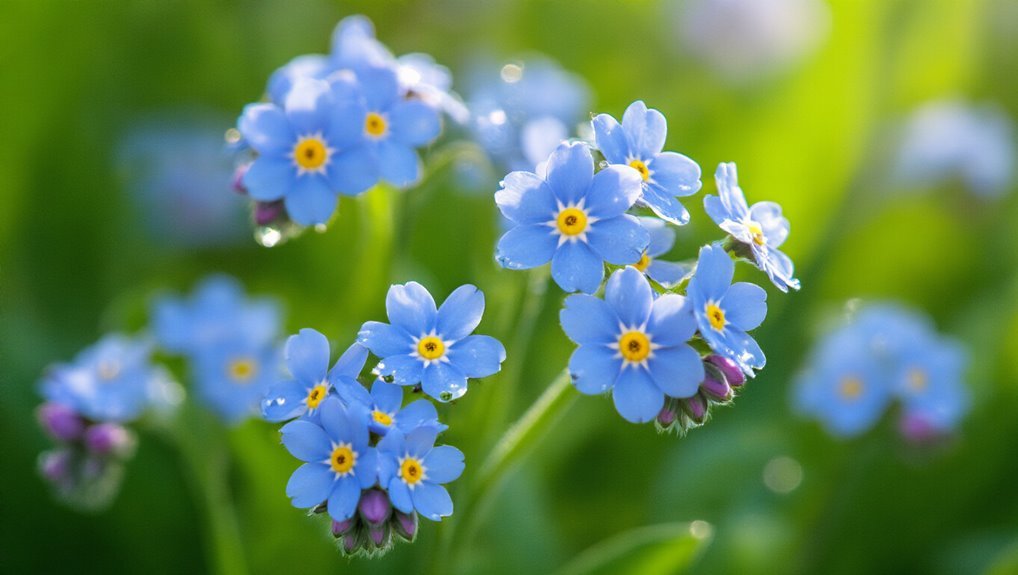
If you’re looking for a charming addition to your garden, forget-me-nots are a delightful choice. These tiny, vibrant blue flowers bloom in spring, creating a beautiful carpet of color. They thrive in partial shade and prefer moist, well-drained soil, making them perfect for those tricky spots in your garden. For those who want to grow fresh herbs indoors, indoor herb gardens are a practical and rewarding option that can bring greenery and flavor to your kitchen year-round.
To make the most of your forget-me-nots, consider these tips:
- Companion Planting: Pair them with ferns or other shade-loving plants for an eye-catching display.
- Self-Seeding: They’re great for naturalizing; they’ll return year after year if you let them self-seed.
- Wildflower Gardens: Use them to attract pollinators in your wildflower beds, enhancing biodiversity.
You can also start your forget-me-nots from seed using Herb Garden Kits with Seeds and Pots, which makes it easy to grow a variety of plants right at home.
With forget-me-nots, you’ll add a touch of nostalgia and beauty to your garden!
Agapanthus
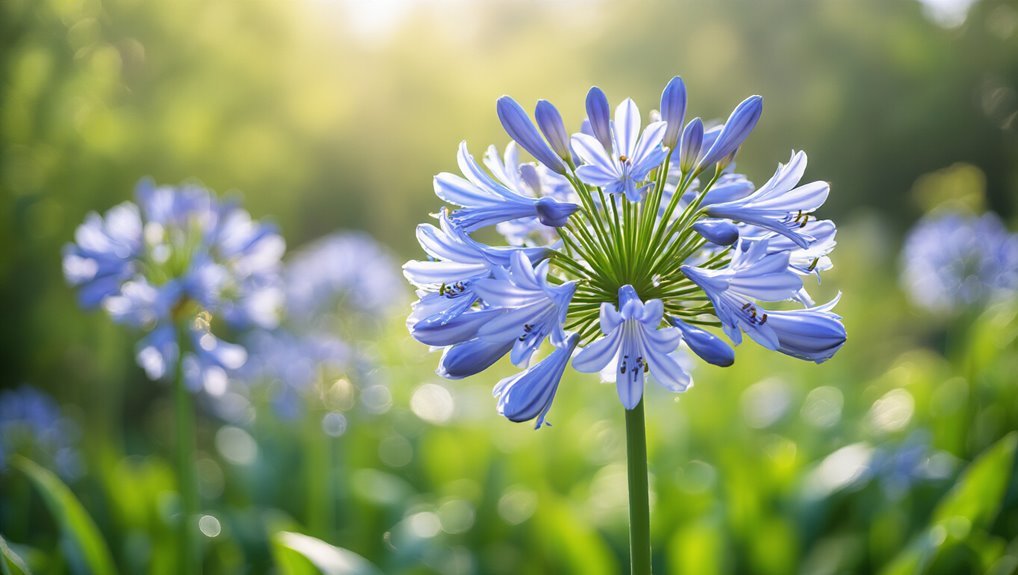
Agapanthus, commonly known as African lily, brings a striking elegance to your garden with its bold clusters of blue flowers. These perennial plants thrive in sunny spots and are perfect for borders or as focal points. They require minimal care and can withstand drought, making them ideal for low-maintenance gardens. For a stylish and functional display, consider showcasing your Agapanthus in beautiful plant pots that elevate your space and complement your garden decor. You’ll love how they attract pollinators like bees and butterflies, adding life to your outdoor space. For even easier care, consider growing your Agapanthus in self-watering planters to help maintain consistent moisture with minimal effort.
| Feature | Description | Care Tips |
|---|---|---|
| Flower Color | Deep blue to violet | Water regularly |
| Height | 1 to 4 feet tall | Fertilize annually |
| Bloom Season | Summer to early fall | Deadhead spent blooms |
| Sunlight | Full sun to partial shade | Mulch for moisture |
With Agapanthus, you’re sure to create a stunning display!
Frequently Asked Questions
How Do I Choose the Right Location for Blue Flowers?
To choose the right location for blue flowers, you’ll want to assess sunlight, soil type, and drainage. Find a spot that gets at least six hours of sunlight daily and has well-draining soil for optimal growth.
What Soil Type Is Best for Growing Blue Flowers?
Imagine rich, loamy soil cradling your blue flowers, providing essential nutrients. You’ll want well-draining soil, ideally with a slightly acidic to neutral pH. Mix in organic matter, and watch your blooms thrive under the sun!
How Often Should I Water Blue Flowers?
You should water blue flowers about once a week, ensuring the soil stays moist but not soggy. During hot, dry spells, you might need to increase frequency. Always check the soil’s moisture level first.
Are Blue Flowers Deer-Resistant?
Yes, some blue flowers are deer-resistant, but it varies by species. You’ll want to research specific flowers you’re interested in. Incorporating strong scents or textures can also deter deer from munching on your plants.
Can Blue Flowers Attract Pollinators?
Yes, blue flowers can attract pollinators like bees and butterflies. Their vibrant color and unique scents draw these beneficial insects, helping your garden thrive. Planting them encourages a healthier ecosystem and supports local wildlife.
Conclusion
Incorporating blue flowers into your garden creates a serene oasis reminiscent of a clear summer sky. Whether you choose the towering delphinium or the delicate forget-me-not, each bloom adds its unique charm, inviting tranquility and beauty. Just like a painter’s palette, these blossoms can transform your outdoor space into a vibrant masterpiece. So, plant these stunning blue flowers and watch your garden flourish, becoming a peaceful retreat where you can escape and recharge.
